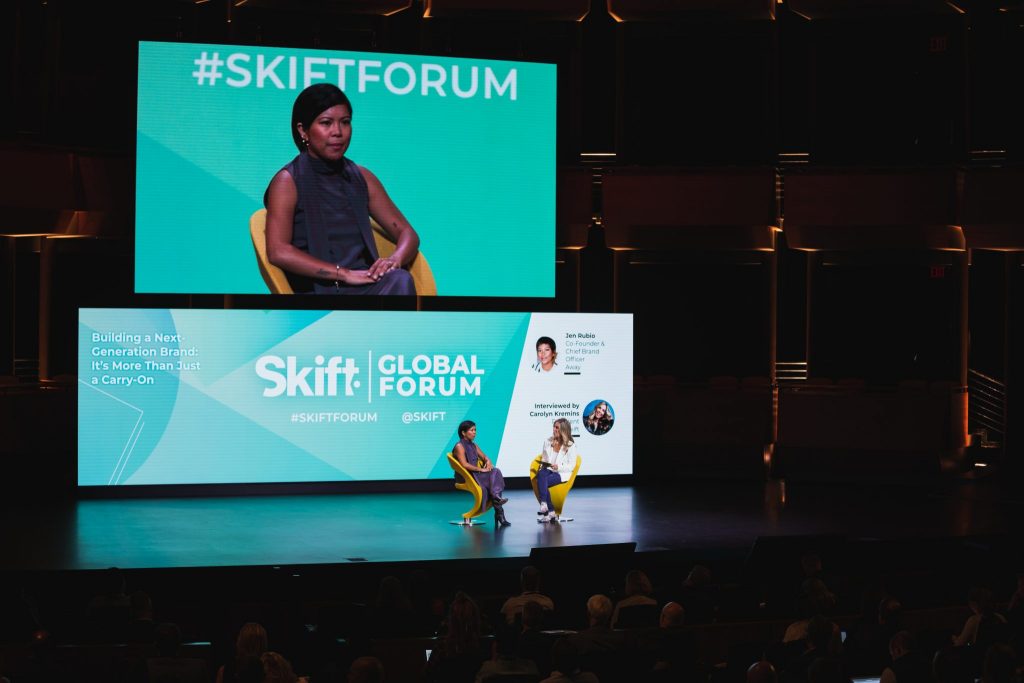Skift Take
Away may have created a suitcase that quickly attained cult status — but the customer insights and sensibility that drive the company are refreshingly cautious.
 A few years ago, right around the time she co-founded cult luggage company Away, Jen Rubio mused to a friend about what her end-game might be: Sell a million suitcases, she predicted, and then sell the company for somewhere in the range of $100 million.
A few years ago, right around the time she co-founded cult luggage company Away, Jen Rubio mused to a friend about what her end-game might be: Sell a million suitcases, she predicted, and then sell the company for somewhere in the range of $100 million.
Just six months later, her company was valued at that sum, and found herself in need of a new goal. “I’m very bad at predicting the future,” she said at Skift Global Forum 2019 in New York on Wednesday to laughs from the audience.
In May, Rubio and her co-founder Steph Korey raised $100 million for the direct to consumer company, bringing its valuation to $1.4 billion. After finding undeniable success in the “very crowded, commoditized product market” of luggage, they are turning their efforts to new travel-adjacent categories, including clothing and skincare.
To do so, they will rely on the obsessive customer-centric approach that has brought them success with their suitcases. Her advice to other travel companies who are looking to create the same buzz? Your customer has a lot of insight for you; make sure you’re listening.
“I think a lot of companies don’t even know who their customers are. They try to get data and [bring in] consultants [to find out.] Nobody knows that better that you,” Rubio said. “That’s why we’re so obsessed with having a direct relationship with our customers” which spans online feedback on social media as well as Away’s brick and mortar outlets. “We just listen. We still read all the Instagram comments.”
She noted that the company already knows, for example, that their customers want to travel in comfortable clothes — but not resign themselves to wearing athleisure on the airplane. With those kinds of subtle insights, Away can create products that solve problems for its customers. The challenge now is: “How do you present that in a way that’s aspirational?”
Of those deftly curated Instagram ads that have made the Away bag an aesthetic status symbol online as much as a coveted piece of luggage, Rubio said that the groundwork came way before Away spent money on paid marketing.
“What makes our paid marketing so efficient and impactful is that we have invested so much in the brand marketing, PR, and influencer relationships that get us in people’s minds early on,” Rubio said. “So by the time they do get that Instagram ad, it’s very efficient for us. That was strategic from the beginning.”
Away has also intentionally avoided partnering with any established travel brands, instead preferring more offbeat brand collaborations with the likes of the NBA, the Minions film franchise, and most recently the bakery Flour Shop. Rubio noted that roughly half of their sales come from word of mouth referrals.
“We put our products in front of people not just when they’re on a trip — but [in a way that means] they can think about (them) all the time.”
So what’s next on the horizon: An IPO, a buyout, acquisitions? “We’re trying to build a scalable business — which is the most boring answer I could give you,” Rubio said. But she went on to give some words of wisdom gained from watching some of today’s most revered brands weather their own growing pains.
“We’ve realized as we’ve scaled that the companies that are going public now are getting stuck because they don’t have a path to profitability or a real biz model. We’ve always been conservative in how we’ve grown.”
The Daily Newsletter
Our daily coverage of the global travel industry. Written by editors and analysts from across Skift’s brands.
Have a confidential tip for Skift? Get in touch
Tags: sgf2019, skift global forum
Photo credit: Jen Rubio (left), co-founder and chief creative officer of Away, speaking at Skift Global Forum on September 18, 2019, in New York. Matt Mateiescu / Skift
